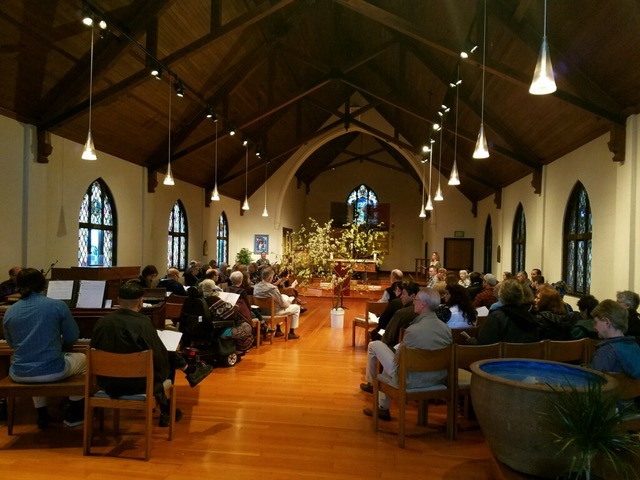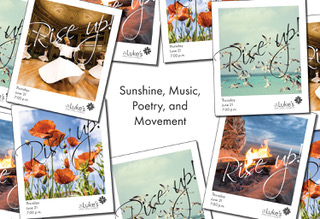by Kevin Pearson and Josh deLacy
Holy mystery abounds in the Pacific Northwest’s mountains, forests, and coastlines. In a 2007 UC, Berkeley study entitled The Nature of Awe, nature, music, and art—in that order—ranked as primary elicitors of this profound experience. For most people in this region, church doesn’t spark that connection to the divine. Those who have experienced an evening seasonal liturgy at St. Luke Church in Renton, WA, however, tell a different story. St. Luke’s offers liturgies on every solstice and equinox to honor the changing seasons—not only the budding branches and dropping leaves of the natural world, but also the shifting seasons of the Spirit in our own internal lives.
The liturgies began as a collaboration between The Rev. Kevin Pearson and musician Charles Rus, as a way to speak to this particular Pacific Northwest context. Over the last two years these liturgies have grown a following, attracting participants of all ages who find special sustenance in these liturgies, including many who wouldn’t be caught dead in a church, except this church. Whatever their religious background, their arrival is met by a carefully choreographed adventure into the sacred. Through poetry, the beauty of art, meditations, movement, ritual, and silence, the divine life is evoked. You won’t hear a sermon or celebrate Eucharist (at least in their normative forms); still, St. Luke’s seasonal liturgies carefully provide structure for formlessness and time for eternity.
It is no secret that early Christian authorities set the dates of many of the church’s holy days and liturgical seasons in uncanny parallel with earlier celebrations that were more earthen in nature. We have come full circle: the tension and competition between the early church and Paganism have been forced into a non-compete clause of sacred ecology. Dominion and “subduing the earth” have traded their spears for pruning hooks of environmental stewardship. The solstices and equinoxes—marking the sun’s relationship to the earth, the lengths of day and night, the tides, and the seasons of the year—affect how we live upon this earth. For the attuned, one could say these events are high holy days of nature’s prayerbook. Noticing their synchronicity with our own spirit-lives is part of living at a higher consciousness.

The liturgies hold loosely to An Order for Evening and go off-trail into a greater array of languages and expression than is normally prescribed. The languages of poetry, music, movement and visual art “spoken” in our world and cultures often communicate sacred mystery in fresh and profound ways. By drawing these new expressions into the church’s worship, St. Luke’s acknowledges, honors, and utilizes their sacral qualities.
The poems, songs, and visual art St. Luke’s curates encourage devotion to God, to the way of Jesus, and to a Holy Spirit who speaks whatever language she wants. Christian tradition wisely defines the Holy Spirit in loose terms, leaving her plenty of space. She is the wildcard of God, and St. Luke Church ensures she has especially elastic pants. She grooves to Hindustani tunes, native flutes, rock & roll, The Wailin’ Jennys, and Sweet Honey in the Rock. She sings through Irish love songs, gospel, Gregorian chant, and from the 1982 Hymnal. She lifts every voice as she sings in our souls and our souls sing back. Poets ancient and modern, writers resident and local and worlds away, and visual artists of all mediums press heads to hearts and open vistas inside and out that flat-out alter people.
The Rev. Jim Friedrich, who blogs as the Religious Imagineer, is a regular participant at the seasonal liturgies. He said, “I entered the church at the Spring Equinox, and there was a great and beautiful blossoming tree set in the midst of the nave. Through its branches I could make out the icon of Jesus. It was a metaphor for the entire liturgy: nature was a window into the divine, with earth and heaven sharing an equal radiance.”
Music, above all, drives these liturgies. As the seasons have evolved and musical leadership has passed from Charles Rus to Jack Barben and now to Mel Butler, the circle of participating musicians has grown wider and wider. These liturgies attract a myriad of musicians delighted to “play in,” unbounded by a narrow definition of what is sacred and what genres should intertwine. Musicians of one stripe or another join together in an amalgam of genre and style. An Indian tabla player brings the rhythms of Hindustani classical music and melds it into a blues swing. A saxophonist fashions jazz lines into contemplative chant. A classically trained cellist plays a soaring solo over a folk ensemble of banjo, string bass, and drums. This collaboration or fusion is the special sauce of these seasonal liturgies—drawing in people of all kinds, places, and ways and letting their voices be heard in worship.
In these liturgies, St. Luke’s selects and composes and constructs what speaks to us, in these times—not only with music, but with art, poetry, story, and liturgical structure. A seasonal liturgy at St. Luke’s appreciates what moves us, whether or not it fits within the box of a particular style or form.
Charles Rus says his greatest stroke of liturgical ingenuity was leading a congregation in a soulful rendition of the simple nursery rhyme Row, Row, Row Your Boat—so clearly did it transport people downstream to the divine. Over-attention to form (or Spirit) troubles religion today. We’ve lived through a time in the church when the sun rose and set on form (particularly the forms of music and language), a time when we didn’t see how bound we were to convention, culture, and class. Religious traditions that are enslaved to form have little resonance; conversely, those unmoored in Spirit have scant holding power or traction. Striking an authentic synthesis of form and spirit is key to an enduring and thriving religious life.
The openhandedness of St. Luke’s seasonal liturgies unveils the wonder of life right before us; the liturgies become more about our opening, our waking. When that occurs, differences over the appropriate art and music drop away. Pearson proclaims, “The worship wars of the last generation were largely fought over form; that war is over and everyone lost. Lay down your sword; this is the season of the sacred and of love. We’re breaking down every barrier that keeps people from the holy.” The music and other arts we employ in these liturgies are traditional and novel, beautiful and resonant, “right now” and timeless. They are sacred, deeply holy – once sacred is set free of how it is allowed to be.
“I think deeply about how I can open the door to the holy in worship,” says Pearson. “This was once the art that defined priesthood: unveiling the sacred, holding those gathered in sacred space and time, and not infringing upon the Spirit’s work. This priesthood would be in danger of extinction were it not for the irrepressible ways and means of God to make even rocks cry out. In our times, when the church has lost its voice for many in our culture, St. Luke’s is helping rocks to cry, sunsets to speak, and mountains to sing.”
Pearson remembers an elderly woman from a neighboring parish grabbing ahold of him after attending several seasonal liturgies, saying, “I want to tell you something, but I don’t want you to think this is about you. It’s not about you. God is using you and what you do here to speak to me. To speak to all of us.” That, for Pearson, is the prize above all prizes.
One thing does not happen at St. Luke Church’s seasonal liturgies: when they’re over, no one runs for the door. The sense of the sacred is so palpable that people stay seated, mingle with others, and share their experiences—reminiscent of a gallery opening—lingering in this moment in time when the world is new.
The summer solstice is right around the corner with the theme Rise Up! On June 21, St. Luke Church will sing ’til the setting sun, sway sweetly to the moon, link up in the dance, and know once more of the invisible one who becomes visible on these nights and is refracted in the glinting eyes of gathered souls. You would be welcome.
Kevin Pearson has been rector of St. Luke Church in Renton, WA for fourteen years. He is the author of Primary Religions Experience: Occasioning Transcendence in Christian Worship. Josh deLacy is the author of Traveling on Trust, dozens of personal essays, and Communications Director and parishioner at St. Luke Church. St. Luke is located at 99 Wells Ave. S. Renton, WA 98057. stlukesrenton.org.

